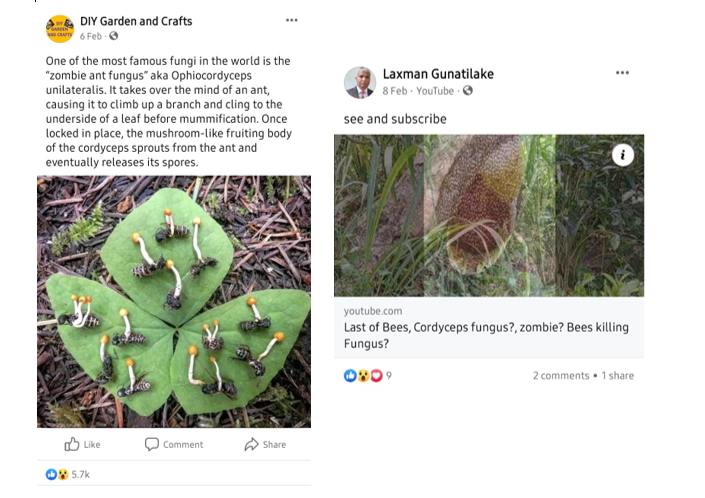Physical Address
23,24,25 & 26, 2nd Floor, Software Technology Park India, Opp: Garware Stadium,MIDC, Chikalthana, Aurangabad, Maharashtra – 431001 India
Physical Address
23,24,25 & 26, 2nd Floor, Software Technology Park India, Opp: Garware Stadium,MIDC, Chikalthana, Aurangabad, Maharashtra – 431001 India

Zombies are fictional characters mostly seen in horror movies and science fiction. A zombie is when a person who loses control over his own body. It is like some other force is controlling the body of the person who is attacked.
Normally, a zombie is created in science fiction due to a viral infection spread by blood contamination.
A group of people in the world believes that there will be zombies in the future of our planet. But is there any possibility for this belief to come true in the near future? Have there been any incidents in the world related to zombies?
The Climate Fact Checks team wanted to investigate this, following up on our article Zombie Virus & Impacts of Climate Change on Re-Emergence of Viruses! We looked into whether Climate Change has increased the prevalence of such threats on the planet.
Zombie-ant Fungus
Zombie-ant fungus is an insect-pathogenic fungus that can be commonly found in tropical forest areas. The scientific term for this fungus is Ophiocordyceps unilateralis. This fungus was discovered in 1859 by British scientist Alfred Russel Wallace. This fungus belongs to the phylum Ascomycota.
This parasitic fungus reaches the foraging ants and penetrates their exoskeleton. Then it slowly grows while taking control of the ant’s behavior.
When the fungi infection advances, the ant leaves its nest and its normal habitat. The ant makes its own microclimate with more humidity, mostly on trees, which matches the needs of the infected Ophiocordyceps unilteralis fungus. The infected ant will then sink its jaws into a leaf vein and wait for its last breath. The parasitic fungi grow inside the ant’s body as it feeds on its victim’s innards.
The ant dies due to harsh environmental conditions, food scarcity, and the pressure applies by its parasite. Two days after the ant’s death, the fruiting body of the parasitic fungi inside the body comes out through the base of the ant’s head.
This fruiting body spreads its spores and infects more and more ants. Read more about this fungal infection here.

Cordyceps Fungi
Just like Ophiocordyceps unilateralis, there are many other species of cordyceps fungi. Most of them are endoparasites, which mainly act as pathogens to insect species and other arthropods. Ants, spiders, bugs, butterflies and even caterpillars can be a victim of these fungi.
But the most famous zombie fungus is Ophiocordyceps unilateralis. Only this species is found to control the mind and the behavior of its host from the cordyceps species. Though the other species infect a host arthropod and kill it as the final result, it cannot make extreme behavioral changes in the host.

ZomBEEs in Sri Lanka!
Few photos and post have been shared on social media platforms, about the new zombie fungi species that has been spreading through bees. Initially they were in international Facebook pages and then there were records about finding the zombie fungus for the first time in Sri Lanka.

Most of the social media users have commented that this is a sign of a great threat.
Climate Fact Checks team contacted Professor Siril Wijayasundara, research professor at the National Institute of Fundamental Studies (NIFS), who was working and researching this incident in Sri Lanka.
He said that there is research currently being conducted on this fungi species on bees to confirm the species of fungi. And the real state of this fungus cannot be predicted accurately yet.
But answering our questions Professor Siril mentioned that this is not an odd situation or anything to be agitated about. These fungi may have existed on Earth and even in Sri Lanka for many years. But the problem arose when people were able to see the impacts of the fungus in nature. He said the recent observations were recorded as the people were more aware of nature and observant of its changes. He said that this is a positive trend.
Also, he mentioned that, though few infected bees were found, the situation was not severe enough to destroy the colonies of bees. Only a handful of colonies were affected.
Can cordyceps fungi affect human life?
It needs to be highlighted that cordyceps fungi only attack arthropod species. Moreover, one cordyceps species cannot infect several types of arthropods at the same time. So, these cordyceps species are species specific to their host.
So, there is no threat to humans being infected by this virus.
However, humans do use cordyceps species for their benefit.
How people make use of the cordyceps fungi
Humans use the parasitic ability of the cordyceps species for pest control purposes on their crops. Cordyceps fumosorosea is the endoparasite for the insects that are harming the crops. So, using this as an eco-friendly pest-controlling method is shown to be effective. Because the preparation of Cordyceps fumosorosea is easy and a low-cost procedure, this can be used as a commercial insect pest-controlling method.
Cordyceps species, Ophioordyceps sinensis is known as a Chinese herb, also named “Dong Chong Xia Cao.” This cordyceps species grows inside caterpillars. This is a valuable herb in Chinese medicine. This can be used in a wide range of disorders, such as renal, liver, respiratory, and cardiovascular diseases. Also, this herb improves energy, appetite, stamina, endurance, and sleeping patterns and effectively treats cough and fatigue.
In some countries, cordyceps is used as food. Due to the above-mentioned properties of cordyceps, people tend to eat them for good health. Higher energy production, anti-aging properties, control of type 2 diabetes, heart health benefits, and help fight inflammation are some reasons it is used as a food. They can be eaten by simply boiling a dosage of cordyceps in water for a few minutes and then lowering the temperature to a simmer for another 15 minutes.
Drawbacks of using cordyceps fungi
Though cordyceps have many advantages to humans, there are several side effects as well. So, it is important to prevent overdosing on cordyceps. Normally, a safe dose of cordyceps is 3 to 6 grams daily for up to one year. However, overdosing causes mild side effects such as diarrhea, constipation, and stomach discomfort.
Cordyceps consumption is not healthy for people with auto-immune diseases. Cordyceps may increase the symptoms of auto-immune diseases by activating the immune system more.
Cordyceps may also increase the risk of bleeding during surgeries. Therefore, at least the final ingestion of cordyceps should be done more than two weeks before surgery to lower its risk.
How does Cordyceps affect the environment?
The main impact of cordyceps on the environmental communities is the threat to populations of arthropods such as ants, bees, wasps, spiders, and butterflies. This may negatively affect the insects themselves. But this type of infection should exist worldwide to control the ecosystem balance.
Flying insects such as bees and butterflies are the best and most common pollinators. So, people believe that as cordyceps have adverse effects on them, it harms the planet.
But this is not true.
Cordyceps have existed in the same world as us for about 1500 years. But still, we cannot see any significant harm done to bee communities, even if it was too hard to notice very well. If cordyceps is that harmful, after 1500 years, we should be able to see a significant number of dead insects.
Like every other organism in the world, cordyceps also has its limitation of diffusion. It will be a disaster if the cordyceps break these limitations by improving their genetic arrangement. But this step is too far from us in reality, yet it would be better for a science fiction story.
Does Climate Change help the rapid distribution of cordyceps
Typically, cordyceps species prefer cold temperatures and more humidity. They cannot be commonly found in dry areas. With the impacts of climate change, preferable climate conditions are minimized for the survival of these fungi. Habitat loss is an impact of climate change that harms the cordyceps population.
Cordyceps is being farmed in Asian countries such as China, Bhutan, and Nepal as Ophiocordyceps sinensis with great demand. However, according to the research article on Range shifts in response to climate change of Ophiocodyceps sinensis, a fungus endemic to the Tibetan Plateau, habitats will be lost for Ophiocodyceps sinensis. As a result, the farmed population of Chinese caterpillar fungi and the natural population have been endangered.
Conclusion
Zombie fungi are not a new topic to the world though most humans are unaware of that. Even “The Last of Us” TV series was scripted with the background of cordyceps. But as people are more aware of TV series than mysteries of nature, they used to think that the original one was from the series and the concept will be proven with real-life fungi.
Cordyceps is not harmful or a threat to the human species. But it is an excellent resource beneficial to humans.
Today cordyceps fungi are in danger due to Climate Change. If destroyed, it would be a significant loss to the ecosystem and, ultimately, to all life on the planet.
_With Inputs from Mihiri Saparamadhu–